Neuronal circuit-dependent neuroprotection by interaction between nicotinic receptors
a neuroprotection and neuronal circuit technology, applied in the field of neuronal circuit-dependent neuroprotection by interaction between nicotinic receptors, can solve the problems of impaired nervous system function, impaired memory, impaired coordination of movements,
- Summary
- Abstract
- Description
- Claims
- Application Information
AI Technical Summary
Benefits of technology
Problems solved by technology
Method used
Image
Examples
example 1
Slice Preparation and Electrophysiological Recordings
[0091]Male Sprague-Dawley rats (120-200 g) were maintained and sacrificed according to standard procedures reviewed and approved by the Institutional Animal Care and Use Committee. The ex vivo methods for the dissection of hippocampi and the preparation of slices have been described previously (Ferchmin P. A., et al., J Pharmacol Exp Ther 505:1071-1078 (2003)). Briefly, hippocampi were dissected over ice; transversal 400-μm-thick slices were cut with a manual slicer and immediately transferred to the incubation chamber, thus preserving the neurons in their native environment. The chamber consisted of a temperature-controlled bath surrounding an acrylic plate covered with nylon mesh; the plate was divided into three lanes with independent perfusion. For dissection and incubation, a standard artificial-cerebrospinal fluid (ACSF) saturated with 95% O2, 5% CO2 was used and contained (in mM): 125 NaCl, 3.3 KCl, 1.25 NaH2PO4, 2 MgSO4, 2...
example 2
Procedure for Testing Neurotoxicity and Neuroprotection
[0093]About 30 slices from the hippocampi of two rats were distributed equally among three lanes of an incubation chamber. A maximum of seven slices were analyzed per lane for each individual experiment, and on average 21 slices per condition were tested for each experimental condition. The excitotoxic stimulus was 0.5 mM NMDA for 10 min in the presence of 95% C % 5% CO2, and 10 mM glucose. Because the neurons are maintained in their native environment and in contact with other cells, stimulation with the appropriate stimulus can elicit a PS. One hour after dissection, each slice was stimulated with a stimulus twice the strength required to elicit a threshold PS. This initial response was recorded as PS area (msec X mV) and compared to the final response elicited by the same stimulus strength recorded from the same position after the experimental treatment was finished. The slices were washed for 1 hr with normal ACSF to elimina...
example 3
Western Blotting Analysis
[0097]Slices were prepared and maintained as described above. Treatments started after 2 hr of incubation in ACSF. The tobacco cembranoid 4R, dissolved in DMSO, was applied as needed for each experimental condition. At the corresponding time, each slice was removed and the CA1 region microdissected, frozen on dry ice, and stored at −80.degree. C. until assayed. Control slices not exposed to 4R were incubated in ACSF with the same concentration of DMSO as experimental slices. The CA1 regions were sonicated briefly in ice-cold homogenization buffer (pH 7.0) containing: (in mM) 20 HEPES, 2 dithiothreitol (DTT), 10 MgCl2, 0.2 PMSF, 15 sodium pyrophosphate, 2 sodium orthovanadate, 5 sodium metavanadate, 50 NaF, and 0.1 mg / ml bovine serum albumin (BSA) with an additional mixture of peptide inhibitors (leupeptin, antipain, bestatin, chymostatin, and pepstatin each at a final concentration of 1.6 μg / ml). An appropriate volume of Laemmli sample buffer with 2-mercapto...
PUM
| Property | Measurement | Unit |
|---|---|---|
| Molar density | aaaaa | aaaaa |
| Molar density | aaaaa | aaaaa |
| Concentration | aaaaa | aaaaa |
Abstract
Description
Claims
Application Information
 Login to View More
Login to View More - R&D
- Intellectual Property
- Life Sciences
- Materials
- Tech Scout
- Unparalleled Data Quality
- Higher Quality Content
- 60% Fewer Hallucinations
Browse by: Latest US Patents, China's latest patents, Technical Efficacy Thesaurus, Application Domain, Technology Topic, Popular Technical Reports.
© 2025 PatSnap. All rights reserved.Legal|Privacy policy|Modern Slavery Act Transparency Statement|Sitemap|About US| Contact US: help@patsnap.com



